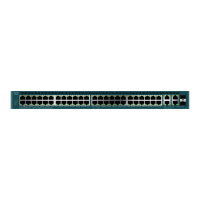Port Management
Configuring Link Aggregation
159 Cisco 500 Series Stackable Managed Switch Administration Guide Release 1.3
10
To configure a dynamic LAG, perform the following actions:
1. Enable LACP on the LAG. Assign up to 16 candidates ports to the dynamic LAG
by selecting and moving the ports from the Port List to the LAG Members List
by using the LAG Management page.
2. Configure various aspects of the LAG, such as speed and flow control by using
the LAG Settings page.
3. Set the LACP priority and timeout of the ports in the LAG by using the LACP
page.
Defining LAG Management
The LAG Management page displays the global and per LAG settings. The page
also enables you to configure the global setting and to select and edit the desired
LAG on the Edit LAG Membership page.
To select the load balancing algorithm of the LAG:
STEP 1 Click Port Management > Link Aggregation > LAG Management.
STEP 2 Select one of the following Load Balance Algorithms:
• MAC Address—Perform load balancing by source and destination MAC
addresses on all packets.
• IP/MAC Address—Perform load balancing by the source and destination IP
addresses on IP packets, and by the source and destination MAC addresses
on non-IP packets
STEP 3 Click Apply. The Load Balance Algorithm is saved to the Running Configuration file.
To define the member or candidate ports in a LAG.
STEP 1 Select the LAG to be configured, and click Edit.
STEP 2 Enter the values for the following fields:
• LAG—Select the LAG number.
• LAG Name—Enter the LAG name or a comment.
• LACP—Select to enable LACP on the selected LAG. This makes it a dynamic
LAG. This field can only be enabled after moving a port to the LAG in the next
field.

